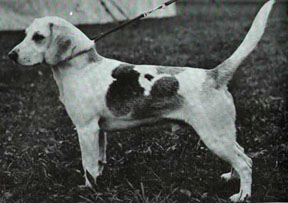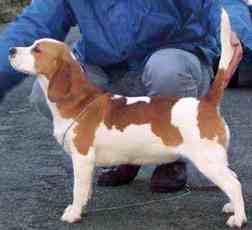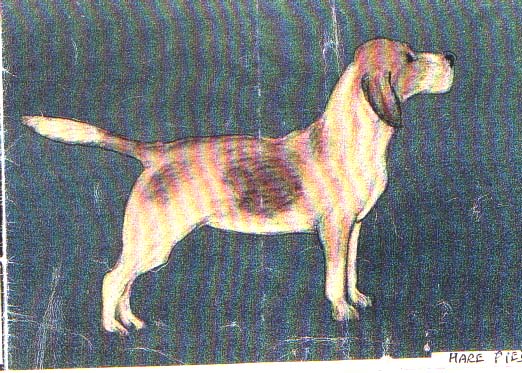
The Pieds
This coloration seems mostly to be acknowledged in Great Britain, although upon closer inspection of some of our so called "shaded and faded tris" in the US, it might appear that this coloration also exists in the "Colonies".
To quote from "Any True Hound Colour" by Andrew Smalley
(noted long-time British breeder)
Published July 1982 by Philip and Sylvia Tutchener (Beacott beagles)
Colored drawings are from the Smalley booklet
"This group is probably the most contraversial of all.
It has the widest range of shades and creates the most disagreement over
definition. The pied colours are the hare pied, badger pied and the lemon pied,
and each is basically just one colour with a darker shading. The darkest colour
is the badger pied,the lightest is lemon pied and the inbetween tan colour is
the hare pied. The fundamental difference between this group and the other
groups is that the white is not the clear white of the other groups but is a
pale cream colour so pale that it appears white. The colour pattern is
distributed in the usual way on the body, head etc., but the predominatong
colour is still the creamy white with the pigmentation spread in patches,usually
in the saddle and side areas.
"Firstly the badger pieds-this colour has the nearest base colour to
white of all the three. In this case the colour is a mixture of black, silver
and fawn hairs within one group, creating an overall 'badger' effect. The
colour is spread about amongst the ground colour, without there being a
clear definition or dividing line between the base colour and full colour. The
edges of the dense colour pattern area fade and run out, mingling with the base
colour. It is NOT a clear line as in the other groups.

Notice that the colors fade into not only each other but into the white with no clear lines of demarcation. This is the major difference between a faded tri and a true pied.
"The hare pied follows the same pattern of distribution, but there
are fewer black hairs and more tan mixed in--not in patches, but all mixed up
together, giving the colour of a hare, again with no dividing line but the
colour blending in with the cream base coat.


"The lemon pied carries the pigment of the red group in its lighter
shade giving cream or lemon with the off white background. These are the only
two colours, but are mingled by individual hairs in the blending effect already
described. These can be so dilute as to be almost non-existent and you get
particular in the lemon pied, that you get a cream or virtually pure whitehound.
"This pied group of colours forms practically the whole of the various colours
found in present day foxhounds because colours have now been bred to each other
for at least 50 years and the colour is now firmly established in many packs.
However, once the darker colours are re-introduced the lighter colours are soon
lost and this is why so few exist in the show world, with the dark tri colour
being the more popular colour. Though when the pied colour is carried in the
background it can of course manifest itself on rare occasions. One dog hound of
this colour (badger pied) is behind many of our present day show beagles, so it
can come out in later generations, although it is very very unlikely."